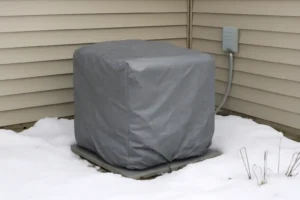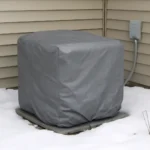Indoor air quality (IAQ) is often an overlooked aspect of maintaining a healthy home, but it plays a crucial role in your overall well-being. With most people spending a significant amount of time indoors, it’s important to ensure the air you’re breathing is clean and free from harmful pollutants.
Indoor air can often be two to five times more polluted than outdoor air, which can lead to both short-term and long term health problems. Whether it’s respiratory issues, allergies, or even heart disease, poor air quality can have a profound effect on your health.
In this article, we will explore the major sources of indoor air pollution and provide practical, effective solutions on how to improve indoor air quality in your home.
What Affects Indoor Air Quality?

Indoor air quality is affected by several pollutants, both visible and invisible. Understanding these pollutants and their sources is the first step in improving your home’s air.
1. Radon
Radon is a naturally occurring radioactive gas that is odorless, tasteless, and colorless. It enters buildings through cracks in walls, floors, and foundations. Long term exposure to high levels of radon can increase the risk of lung cancer, making it one of the most dangerous indoor pollutants. The good news is that radon can be easily detected with a radon test kit, and mitigation systems can be installed to reduce its presence in your home.
2. Particulate Matter (PM)
Particulate matter refers to tiny particles suspended in the air, including dust, pet dander, tobacco smoke, diesel emissions, and mold spores. These tiny particles are small enough to enter your lungs and, over time, can lead to respiratory problems such as asthma, bronchitis, and other lung diseases. High levels of particulate matter are also linked to increased risks of heart disease and stroke.
3. Volatile Organic Compounds (VOCs)
VOCs are gases emitted from products or materials like paints, cleaning agents, and furniture. Common VOCs include benzene, formaldehyde, and toluene. Breathing in VOCs can lead to a variety of health problems such as headaches, nausea, eye irritation, and even long term damage to the liver, kidneys, and central nervous system.
4. Allergens
Indoor allergens, such as pet dander, dust mites, mold, and cockroach droppings, are some of the most common contributors to poor indoor air quality. These allergens can trigger respiratory symptoms, particularly for individuals who suffer from asthma, allergies, or other respiratory conditions.
Airease is a trusted brand offering top quality air solutions to enhance your home’s air quality. Contact a professional for Airease air solution installation today!
How to Improve Air Quality in Home: Simple and Effective Solutions
1. Source Control: Eliminate or Reduce Pollutant Sources
The most effective way to improve indoor air quality is by eliminating or reducing the sources of indoor pollutants. For example:
- Asbestos: If your home contains asbestos materials, sealing or enclosing them can prevent the release of harmful particles into the air.
-
Gas Stoves: If you have a gas stove, consider adjusting the burners to minimize the amount of gas emissions. You could also use exhaust fans while cooking to ventilate the area.
-
Cleaning Products: Switch to non-toxic, eco-friendly cleaning products that do not release harmful chemicals into the air.
By targeting these pollutants at their source, you can reduce the overall pollutant load in your home, making the air cleaner and safer to breathe. Contact Professional Experts to take action for a healthier home.
2. Increase Ventilation: Let Fresh Air In

Good ventilation is key to improving indoor air quality by diluting and removing indoor air pollutants. Here’s how you can improve ventilation in your home:
- Open Windows: On days when the outdoor air quality is good, open your windows to allow fresh air to circulate. This will help dilute indoor pollutants and bring in cleaner air.
-
Use Exhaust Fans: Installing exhaust fans in high-moisture areas like bathrooms and kitchens can help remove pollutants like mold, cooking odors, and smoke from your home.
-
Use a Ventilation System: If you live in a newer home, you might have a mechanical ventilation system, such as an energy-efficient heat recovery ventilator (HRV) or energy recovery ventilator (ERV), that brings in fresh outdoor air while conserving energy.
Ventilating your home, especially during activities that produce high pollutant levels (like painting or using a gas stove), will help maintain a healthy air environment. This is one of the most effective ways of how to improve indoor air quality.
3. Air Filtration: Use the Right Air Cleaner
Air cleaners or purifiers are an effective way to remove airborne pollutants from the air. When choosing an air cleaner, consider the following:
- HEPA Filters: High-efficiency particulate air (HEPA) filters are highly effective in trapping small particles, including dust, pollen, and pet dander. Using a HEPA air purifier can help reduce particulate matter in your home.
-
Charcoal Filters: For VOCs and odors, a charcoal or activated carbon filter is beneficial. These filters are designed to adsorb harmful gases like formaldehyde, benzene, and toluene.
-
Whole-House Systems: If you want to filter the air in your entire home, consider investing in a whole-house air purification system that integrates with your HVAC system. These systems can help reduce pollutants throughout the home.
Be sure to regularly clean and replace filters to maintain the effectiveness of your air cleaners. This is another key step in how to improve indoor air quality. For expert help with air purification, contact us today!
4. Regular Cleaning: Dust and Clean Frequently
Regular cleaning habits play a huge role in improving indoor air quality by reducing dust, allergens, and mold. Here are some cleaning tips:
- Vacuum Often: Use a vacuum cleaner equipped with a HEPA filter to effectively trap dust, pet dander, and other allergens. Vacuuming at least once a week can significantly reduce dust levels in your home.
-
Dust with Microfiber: Use microfiber cloths or damp cloths to dust your home. Dry dusting can stir up allergens and particles, making them airborne again.
-
Wash Bedding and Upholstery: Dust mites thrive in bedding, upholstered furniture, and carpets. Wash bedding regularly in hot water and clean upholstery to remove dust and allergens.
5. Use Houseplants Wisely
Although houseplants have been popularly suggested as natural air purifiers, their effectiveness is still debated. While some studies suggest they can help reduce certain chemicals, they cannot significantly lower levels of pollutants such as VOCs or particulate matter. However, houseplants can still add to the aesthetic of your home and create a calming atmosphere. For a more effective way to how to improve indoor air quality, consider AC installation services that ensure better air circulation and filtration in your home.
Other Considerations for Healthy Indoor Air Quality
Test for Radon
Radon is a silent killer, and it’s important to test your home for this hazardous gas. Radon test kits are available online and at local hardware stores. If your home has high radon levels, a radon mitigation system can be installed to reduce exposure.
Avoid Tobacco and Smoke
Never allow smoking inside your home. Tobacco smoke contains a wide range of harmful pollutants that significantly degrade indoor air quality. If you smoke, do so outdoors to prevent exposing your family to secondhand smoke.
Conclusion
How to improve indoor air quality doesn’t have to be complicated or expensive. By controlling the sources of pollution, improving ventilation, using air purifiers, and maintaining regular cleaning habits, you can create a healthier, cleaner environment for yourself and your family. Whether you’re dealing with allergens, particulate matter, or gases like VOCs and radon, these practical steps will help ensure that the air you breathe at home is safe and clean. Contact Hansons and start making small changes today, and you’ll enjoy better air quality and improved health in no time!













